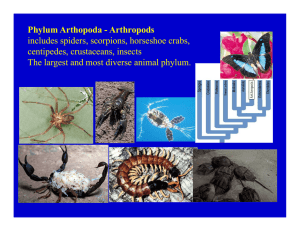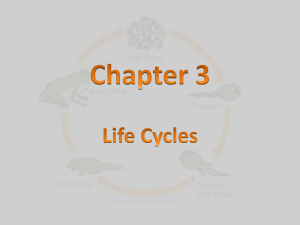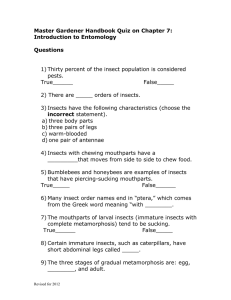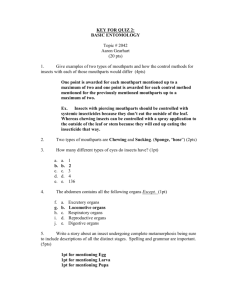Introduction to Entomology Insect Classification no background
advertisement
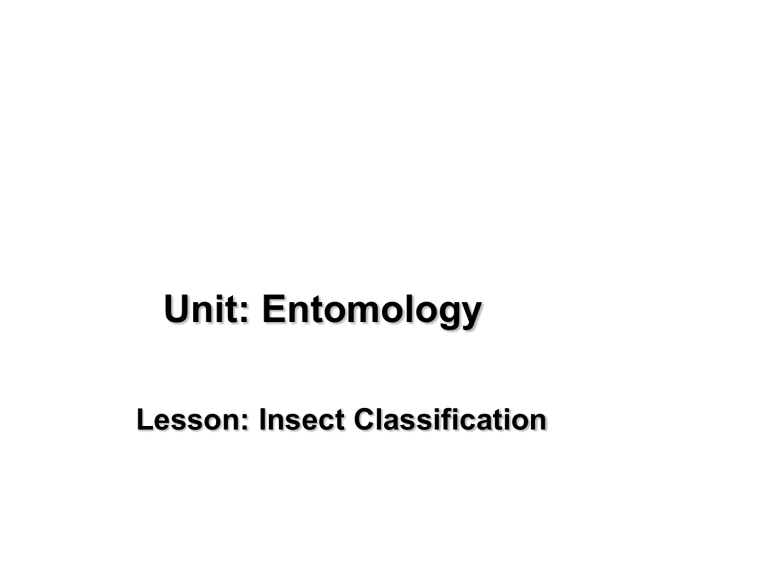
Unit: Entomology Lesson: Insect Classification • What is Scientific Classification? • Scientific Classification is a system used to classify all living things through a breakdown starting with the largest grouping called a Kingdom and continuing down to the smallest grouping called Individual. • Why is Scientific Classification used in the identification of insects? • • Insects can be placed into groupings based upon their physical characteristics. Insects with similar characteristics, number of wings, mouthparts, etc. are placed in a group with other insects that possess the same characteristics. Identification of insect orders aids in prevention and management plans. • Scientific Classification • Kingdom • Phylum • Class • Order • Family • Genus • Species • Where do Insects fit? • Insects belong in the Phylum Arthropoda. The Phylum Arthropoda is characterized by having segmented bodies and jointed appendages. • Lady Beetle - Hippodamia convergens • • • • • • • Kingdom – Animalia Phylum Arthropoda Class - Insecta Order - Coleoptera Family Coccinellidae Genus Hippodamia. Species convergens • 5 Classes of Arthropods • • • • • Class #1- Hexapoda: Insects, six, jointed appendages Class #2- Chilopoda- Centipedes, one pair of legs per body segment, multiple body segments Class #3- Diplapoda- Millipedes, two pairs of legs per body segment, multiple body segments Class #4- Crustacea- Crayfish, five pairs of jointed appendages Class #5- Arachnida- Spiders, four pairs of jointed appendages • There are 31 different orders of insects in the class Hexapoda, sixteen of which are considered of economic importance to agriculturists. The sixteen orders are: • • • • • • • • Orthoptera Hemiptera Homoptera Coleoptera Lepidoptera Diptera Hymenoptera Odonata • • • • • • • • Neuroptera Thysanura Isoptera Siphonaptera Phthiraptera Thysanoptera Dermaptera Blattodea Orthoptera Includes: Indian House Crickets Field Cricket Short-horned Grasshoppers Katydid (Long-horned Grasshoppers) Mouthparts: Chewing Metamorphosis: Incomplete Metamorphosis Damage: Chewing leaves, Crop grains, Fun Facts: Many produce sound through stridulating. Over 20,000 species worldwide. Hemiptera – True Bugs Includes: Assassin bugs Kissing bugs Leaf-footed bug Lygus bug Stink bug Minute pirate bug Big-eyed bug Damsel bug Mouthparts: Piercing-Sucking Metamorphosis: Incomplete Metamorphosis Fun Facts: All of the true “bugs” are in this order. Most have a common v shape on their shield. Homoptera Includes: Cicadas Aphids Armored scales Cottony cushion scale Cochineal scale Leafhoppers Treehoppers Whiteflies Mouthparts: Sucking Metamorphosis: Generally incomplete Fun Facts: Cochineal scales are used in makeup products for the red color. Coleoptera Includes: Beetles and Weevils Blister beetle Boll weevil Collops beetle Darkling beetle (Pinacate or Eleodes beetle) Dermestid beetle Dung beetle Fig beetle Flea beetle Lady beetle (Ladybird beetle/ Ladybug) Long-horned beetle (round-headed wood borer) Palo Verde root borer Metallic wood borer (flat-headed borer) White grub (Scarab beetle larva) 10 Striped June beetle Mouthparts: Chewing, Weevil- Piercing Sucking Metamorphosis: Complete Metamophosis Fun Facts: Coleoptera means sheath wing. Lepidoptera Includes: Butterflies and Moths Bagworm • Two-tailed Swallowtail • Budworm/Bollworm • Pink Bollworm • Grape-leaf Skeletonizer • Salt Marsh Caterpillar • Tomato Hornworm • Sphinx Moth • Monarch • Checkered skipper Mouthparts: Chewing – Caterpillars, Siphoning – adult. Metamorphosis: Complete Metamorphosis Fun Facts: The largest butterfly is the Birdwings that have 11in wingspans. Diptera Includes: Flies, Midges, Mosquito House fly Crane fly Syrphid or hover fly Bee fly Tachinid fly Bot fly Deer fly Mosquito Gall Midge Mouthparts: Sponging, Piercing suckingMosquito Metamorphosis: Complete Metamophosis Facts: Are common vectors of disease. Hymenoptera Includes: Bees, Wasps, Ants Horntail wasp Sawfly Gall wasps Honey bee Leaf-cutter bee Carpenter bee Bumble bee Harvester ant Leaf-cutter ant Fire ant Velvet Ant (mutillid) Paper wasp Ichneumon wasp Thread-waisted wasp Tarantula hawk (spider wasp) Mouthparts: Chewing-Lapping Metamorphosis: Complete Metamophosis Facts: Contain all the social insects except termites. Odonata Includes: Dragonfly, Damselfly Mouthparts: Chewing-Lapping Metamorphosis: Complete Metamorphosis Facts: Live in the water the first year of their lives. After leaving the water they only live a month. Have been around 300 million years. Neuroptera Includes: Green Lacewing Antlion Mouthparts: Metamorphosis: Complete Metamorphosis Facts: Both are beneficial insects. Antlions creat a sand pit to capture unsuspecting prey. Thysanura Includes: Silverfish Firebrat Mouthparts: Chewing Metamorphosis: Incomplete Metamorphosis Facts: Like to lay their eggs in books and wall paper because of the paper and glue. Live 3-5 years Most primitive of all insects. • Isoptera Includes: • Dry-wood termite Subterranean termite Mouthparts: Chewing Mouthparts Metamorphosis: Incomplete Metamorphosis Facts: Live for 15 years. Lay 1 egg every 15 seconds Eat wood. Can destroy a house in 2-3 years. Found in every US state except Alaska. Recycle wood in the soil. • Siphonaptera Includes: Cat and dog flea Mouthparts: Piercing Sucking Metamorphosis: Complete Metamorphosis Facts: Fleas can live 100 days without feeding. Can jump 100 times their own length. Been around more than 100 million years. Females can consume more than 15 times their body weight daily. • Phthiraptera Formally Anoplura and Mallophaga • Includes: Lice • Chewing Louse • Sucking Louse • • • • • • • Mouthparts: Chewing and Piercing-Sucking Metamorphosis: Complete Metamorphosis Facts: Sucking lice feed continuously on lice Chewing lice feed on hair and feathers of animals and humans. Wingless. Do not fly or jump • Blattodea Includes: Cockroaches • American Cockroach • Brown-banded cockroach • Desert Cockroach • Turkish Cockroach • German Cockroach Mouthparts: Chewing Mouthparts Metamorphosis: • Complete Metamorphosis Facts: • Typically Live outside • Walk inside. DO NOT live in the water pipes. • Dermaptera • • • • • • • • • • • Includes: Earwigs Earwig Mouthparts: Chewing Mouthparts Metamorphosis: Complete Metamorphosis Facts: Like humid, dark areas. Release a foul smelling liquid up to 4in away. Oldest known fossil dates back to Jurassic period. • Thysanoptera • • • • • • • • • Includes: Thrip Thrip • Multiples of this pest are still called Thrip. Mouthparts: Rasping-Sucking Mouthparts Metamorphosis: Complete Metamorphosis Facts: Common Pests on flowers, citrus and onions. Ticket Out list 1 insect order 2-5 insects in that order mouthparts in that order lifecycles in that order
